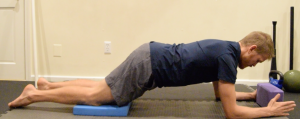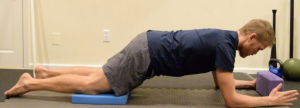YOUR INNER SPRING SYSTEM
Today I want to take a moment and explain to your about your transverse abdominis, aka your TVA. Your TVA is a barrel-shaped layer of your abdominals, and it helps keep the ribcage and pelvis connected. It attaches at several areas of your body, including, the iliac crest (the lateral side of your pelvic bone), posteriorly to the five lumbar vertebrae, anteriorly to the line alba, and on the inside of the last seven ribs (where it then interdigitates with the diaphragm). The easiest way to feel your TVA is to wrap your hands around your waist and cough.
However, beyond that, your TVA plays a crucial role in function and support of your body. First off, on a deep level, it acts as a vacuum on your viscera. It helps to wring out your intestines, improving gastrointestinal movement and assisting in peristaltic movement of the gut. Beyond that, the TVA helps to reduce the diameter of the belly. When contracted, it stabilizes the lumbar vertebrae and allows the stomach to retract (pull) in, and when relaxed it lets the belly expand outward. Because it interdigitates with the diaphragm (which also blends with the psoas) it all plays a crucial role in breathing. Its’ purpose works in conjunction with that of the diaphragm’s, glutes, and adductor muscles.
TVA WORKING MEANS OTHER MUSCLES RELAX
Your TVA is basically your gateway to unlocking, channeling, and accessing your anti-gravity subsystem. What do I mean by this? Basically, if you can learn to engage your TVA, your spine will feel fixed, therefor stable, and allow for you to move, reach, and engage further into your more distal body parts. When your TVA is active your psoas can begin to relax, which can keep us out of a flight-or-fight response, thus increasing the capacity to which we can take new oxygen in, transport it to blood cells in the muscle fibers that need it most, and more quickly expel the waste out of the muscles that already worked (was that too much too fast?). So if your TVA is not functioning, your psoas (which crosses 3 joints; lumbar spine, femur, and hip) will begin working instead. This leads to all kinds of compensations with movement and posture, as well as pain and inflammation of the muscle or joint capsule itself.
In gait- walking, running, throwing, or any other athletic sport, your TVA is best used as a ‘spring system’. For example, when you take a step forward, you want the TVA to absorb the shock in unison with your pelvic floor and glutes because it will prevent the hip from rotating, shifting laterally, or getting out of your control. This is very important because the TVA allows the psoas to relax, and if the psoas is at ease, than your likelihood of recruiting glutes, core, and other leg muscles goes up dramatically. But when this muscle doesn’t understand how to function it will grip on as a protector, and it will prevent your body from functioning optimally. If you’re a runner or walker of any kind (or somebody who plays sports), TVA activation needs to be honed in on to improve your performance and mitigate the chances of injury.
FEELING YOUR DIAPHRAGM
When you take a breath in, you have to think of your diaphragm as lowering down. It is a dome shaped muscle and during inhalation it flattens towards the bottom of your lungs as the lungs expand and your rib basket (thorax) widens. When you breathe out, the diaphragm pulls up towards the heart as a relaxation response of the lungs returning to their normal size (after becoming larger during inhalation). Obviously there are several other diaphragmatic-techniques that come into respiration and muscle activation, such as, fixing the diaphragm via the central tendon by engaging abdominal muscles, keeping it from flattening during inhale. But I’m not here to explain that. I’m here to give you two movements and breathing techniques to use to strengthen what the fitness and exercise community has left out of its’ tool kit when training athletes or average people about using their bodies.
There’s a big difference between having a coach watch you and not. Example below from my video, I think my low back is in a neutral position, but actually I am dumping into it, losing tension in my TVA and rectus abdominis. My suggestion is to have somebody watch you or videotape yourself and be sure you are constantly working towards a neutral spine, engagement on both the front and back side of your body. If you are already experiencing low back pain, the suggested exercise is the supine one (on your back face up), and the forearm plank should be used as a progression only once pain has subsided.
 <–Compensating. Dumping into lumbar spine, creating lorodic curve, anterior tilt
<–Compensating. Dumping into lumbar spine, creating lorodic curve, anterior tilt
 <–Chasing neutrality. Posteriorly tilting pelvis, flattening spine, kyphotic curve
<–Chasing neutrality. Posteriorly tilting pelvis, flattening spine, kyphotic curve
Let me know how it works and remember to train with intention and deliberation. Train yourself to feel and recognize the correct muscles working in all movement!
-Rob

Hi,
Excellent article…. truly informative, indeed!!
I was surfing the net to learn diaphragmatic breathing and found your website. I also saw your videos on core exercises. They are simply brilliant and contain unique information.
Can you please explain ….. why your rib cage is staying arched or dome shaped during core or breathing exercises…?
Exercise world teaches diaphragmatic breathing as belly breathing… in which belly sticks in/out while breathing…. In your exercise videos… belly sticks in/out – along with inflated or arched rib ache during entire exercise.
Is it something like… while we take our first breath in ..we can expand rib cage and then …. rib cage stays fixed in inflated position and we do belly breathing for all subsequent breaths? If it is true…. than can you please explain reasons n behind this breathing mechanics??
I have tried plain belly breathing during exercises but it does not seem to improve my posture.
Thanks …..